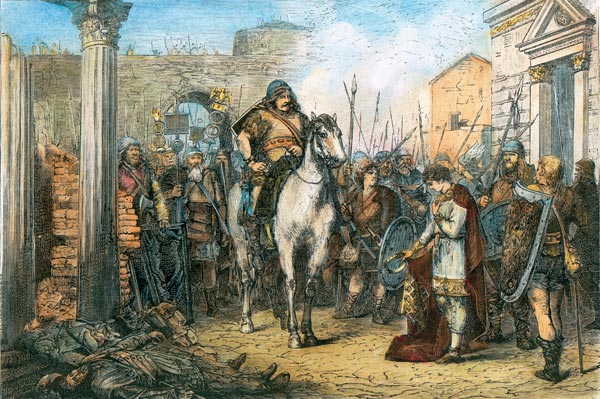Odovacar was the chief of the Heruli tribe of Germans and possibly a member of the Sciri tribe who lived in the Carpathian Mountains in the early fifth century c.e. and were defeated and integrated into the Ostrogothic tribal confederation. His name is probably made of the Germanic elements od, meaning "wealth", and wacar, meaning "vigilant".
Odovacar was a commander of the Germanic mercenaries who were in service of Julius Nepos, the Western Roman emperor (474–475 c.e.). Upon the removal of Julius Nepos by his Romano-Germanic master of the army, Orestes, Odovacar’s troops, mainly made of the Heruli, revolted against Orestes and his son, the puppet emperor Romulus Augustulus.
With Odovacar as their chief, the revolting mercenaries defeated Orestes at Piacenza and removed Romulus Augustulus from the throne and put an end to the Western Roman Empire (476). Odovacar was then confirmed as a patrician by the Eastern Roman emperor, Zeno, and set up his administrative capital in Ravenna, which was already the capital under Julius Nepos and Romulus Augustulus.
  |
Not content with the title of patrician, Odovacar chose to call himself king of Italy (Rex Italiae) and refused to accept the restoration of Julius Nepos to a real position of power, as requested by Emperor Zeno.
In the early years of his reign Odovacar minted coins in the name of Nepos, accepting his superiority in formality. However, Odovacar’s position as the master and king of Italy was established beyond doubt.
In 476 he managed to gain control of Sicily via a treaty with the Vandals of North Africa. This was part of Odovacar’s plan to restore and revive the territorial integrity and the military strength of the Roman Empire, despite occasional setbacks and territorial losses to the Germanic tribes to the north of Italy.
Odovacar changed very little in the administrative system of Italy and ran the government based on the imperial administration of the now defunct Western Roman Empire. He had the approval of the Roman Senate and was largely accepted as the ruler of Italy by the population.
Following provocations for regaining the power by the deposed emperor, Julius Nepos, who was residing in Dalmatia, Odovacar invaded that territory in 481. Shortly after (484), he attacked the western regions of the Eastern Roman (Byzantine) Empire in accordance with a treaty drawn with Illus, commander of the Byzantine forces who was planning to depose Zeno.
The quick territorial expansion of Odovacar, together with his open hostilities against Zeno prompted the latter to provoke the Rugi tribe of Austria to attack Odovacar’s kingdom from the north. Despite the fact that Odovacar managed to defeat the Rugi in their own territory, his rapid expansion and foreign campaigns had made him weak enough to fall prey to Theodoric the Great, the king of the Ostrogoths.
Theodoric, appointed in 488 by Zeno as the king of Italy, repeatedly defeated Odovacar and conquered all of Italy between 488 and 490. In 493 Ravenna, in which Odovacar was taking refuge, also fell to Theodoric. The conqueror made peace with Odovacar by offering to rule Italy jointly with him.





